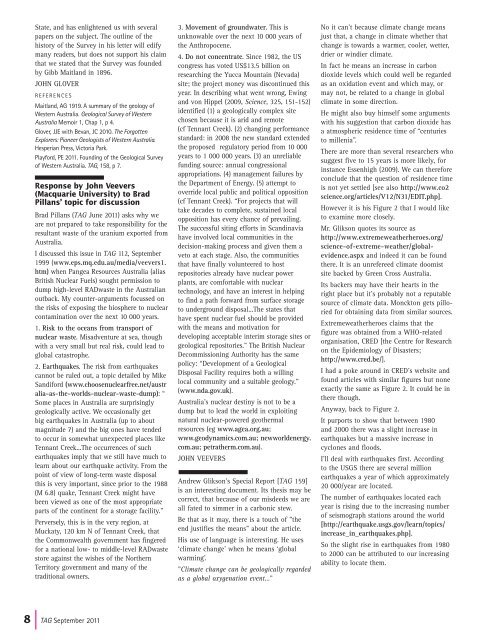TAG - Geological Society of Australia
TAG - Geological Society of Australia
TAG - Geological Society of Australia
Create successful ePaper yourself
Turn your PDF publications into a flip-book with our unique Google optimized e-Paper software.
State, and has enlightened us with severalpapers on the subject. The outline <strong>of</strong> thehistory <strong>of</strong> the Survey in his letter will edifymany readers, but does not support his claimthat we stated that the Survey was foundedby Gibb Maitland in 1896.JOHN GLOVERREFERENCESMaitland, AG 1919. A summary <strong>of</strong> the geology <strong>of</strong>Western <strong>Australia</strong>. <strong>Geological</strong> Survey <strong>of</strong> Western<strong>Australia</strong> Memoir 1, Chap 1, p 4.Glover, JJE with Bevan, JC 2010. The ForgottenExplorers: Pioneer Geologists <strong>of</strong> Western <strong>Australia</strong>.Hesperian Press, Victoria Park.Playford, PE 2011. Founding <strong>of</strong> the <strong>Geological</strong> Survey<strong>of</strong> Western <strong>Australia</strong>. <strong>TAG</strong>, 158, p 7.Response by John Veevers(Macquarie University) to BradPillans’ topic for discussionBrad Pillans (<strong>TAG</strong> June 2011) asks why weare not prepared to take responsibility for theresultant waste <strong>of</strong> the uranium exported from<strong>Australia</strong>.I discussed this issue in <strong>TAG</strong> 112, September1999 (www.eps.mq.edu.au/media/veevers1.htm) when Pangea Resources <strong>Australia</strong> (aliasBritish Nuclear Fuels) sought permission todump high-level RADwaste in the <strong>Australia</strong>noutback. My counter-arguments focussed onthe risks <strong>of</strong> exposing the biosphere to nuclearcontamination over the next 10 000 years.1. Risk to the oceans from transport <strong>of</strong>nuclear waste. Misadventure at sea, thoughwith a very small but real risk, could lead toglobal catastrophe.2. Earthquakes. The risk from earthquakescannot be ruled out, a topic detailed by MikeSandiford (www.choosenuclearfree.net/australia-as-the-worlds-nuclear-waste-dump): “Some places in <strong>Australia</strong> are surprisinglygeologically active. We occasionally getbig earthquakes in <strong>Australia</strong> (up to aboutmagnitude 7) and the big ones have tendedto occur in somewhat unexpected places likeTennant Creek...The occurrences <strong>of</strong> suchearthquakes imply that we still have much tolearn about our earthquake activity. From thepoint <strong>of</strong> view <strong>of</strong> long-term waste disposalthis is very important, since prior to the 1988(M 6.8) quake, Tennant Creek might havebeen viewed as one <strong>of</strong> the most appropriateparts <strong>of</strong> the continent for a storage facility.”Perversely, this is in the very region, atMuckaty, 120 km N <strong>of</strong> Tennant Creek, thatthe Commonwealth government has fingeredfor a national low- to middle-level RADwastestore against the wishes <strong>of</strong> the NorthernTerritory government and many <strong>of</strong> thetraditional owners.3. Movement <strong>of</strong> groundwater. This isunknowable over the next 10 000 years <strong>of</strong>the Anthropocene.4. Do not concentrate. Since 1982, the UScongress has voted US$13.5 billion onresearching the Yucca Mountain (Nevada)site; the project money was discontinued thisyear. In describing what went wrong, Ewingand von Hippel (2009, Science, 325, 151-152)identified (1) a geologically complex sitechosen because it is arid and remote(cf Tennant Creek). (2) changing performancestandard: in 2008 the new standard extendedthe proposed regulatory period from 10 000years to 1 000 000 years. (3) an unreliablefunding source: annual congressionalappropriations. (4) management failures bythe Department <strong>of</strong> Energy. (5) attempt tooverride local public and political opposition(cf Tennant Creek). “For projects that willtake decades to complete, sustained localopposition has every chance <strong>of</strong> prevailing.The successful siting efforts in Scandinaviahave involved local communities in thedecision-making process and given them aveto at each stage. Also, the communitiesthat have finally volunteered to hostrepositories already have nuclear powerplants, are comfortable with nucleartechnology, and have an interest in helpingto find a path forward from surface storageto underground disposal...The states thathave spent nuclear fuel should be providedwith the means and motivation fordeveloping acceptable interim storage sites orgeological repositories.” The British NuclearDecommissioning Authority has the samepolicy: “Development <strong>of</strong> a <strong>Geological</strong>Disposal Facility requires both a willinglocal community and a suitable geology.”(www.nda.gov.uk).<strong>Australia</strong>’s nuclear destiny is not to be adump but to lead the world in exploitingnatural nuclear-powered geothermalresources (eg www.agea.org.au;www.geodynamics.com.au; newworldenergy.com.au; petratherm.com.au).JOHN VEEVERSAndrew Glikson's Special Report [<strong>TAG</strong> 159]is an interesting document. Its thesis may becorrect, that because <strong>of</strong> our misdeeds we areall fated to simmer in a carbonic stew.Be that as it may, there is a touch <strong>of</strong> "theend justifies the means" about the article.His use <strong>of</strong> language is interesting. He uses‘climate change’ when he means ‘globalwarming’."Climate change can be geologically regardedas a global oxygenation event…"No it can't because climate change meansjust that, a change in climate whether thatchange is towards a warmer, cooler, wetter,drier or windier climate.In fact he means an increase in carbondioxide levels which could well be regardedas an oxidation event and which may, ormay not, be related to a change in globalclimate in some direction.He might also buy himself some argumentswith his suggestion that carbon dioxide hasa atmospheric residence time <strong>of</strong> “centuriesto millenia”.There are more than several researchers whosuggest five to 15 years is more likely, forinstance Essenhigh (2009). We can thereforeconclude that the question <strong>of</strong> residence timeis not yet settled [see also http://www.co2science.org/articles/V12/N31/EDIT.php].However it is his Figure 2 that I would liketo examine more closely.Mr. Glikson quotes its source ashttp://www.extremeweatherheroes.org/science-<strong>of</strong>-extreme-weather/globalevidence.aspxand indeed it can be foundthere. It is an unrefereed climate doomistsite backed by Green Cross <strong>Australia</strong>.Its backers may have their hearts in theright place but it's probably not a reputablesource <strong>of</strong> climate data. Monckton gets pilloriedfor obtaining data from similar sources.Extremeweatherheroes claims that thefigure was obtained from a WHO-relatedorganisation, CRED [the Centre for Researchon the Epidemiology <strong>of</strong> Disasters;http://www.cred.be/].I had a poke around in CRED's website andfound articles with similar figures but noneexactly the same as Figure 2. It could be inthere though.Anyway, back to Figure 2.It purports to show that between 1980and 2000 there was a slight increase inearthquakes but a massive increase incyclones and floods.I'll deal with earthquakes first. Accordingto the USGS there are several millionearthquakes a year <strong>of</strong> which approximately20 000/year are located.The number <strong>of</strong> earthquakes located eachyear is rising due to the increasing number<strong>of</strong> seismograph stations around the world[http://earthquake.usgs.gov/learn/topics/increase_in_earthquakes.php].So the slight rise in earthquakes from 1980to 2000 can be attributed to our increasingability to locate them.8 | <strong>TAG</strong> September 2011
















